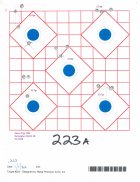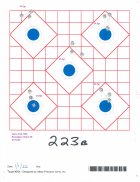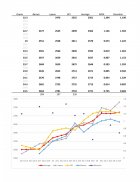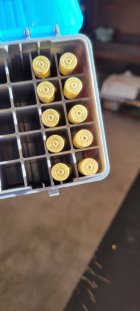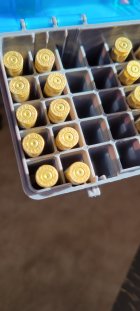Background. I will have some follow-up questions about things I observed while preparing and loading my first batch of hadloads, but I want to go ahead and post the results and get feedback before I test some more tomorrow. I am loading for a Rock River Arms LAR-15 National Match A4 20-inch Comp in .223 Wylde which had fired 585 factory loads before the following range report. I am trying to duplicate the Blackhills 5.56 TMK 77gr and tune it to my rifle. It typically shoots between 0.9" and 1.2".
Brass. I started with 50 fired and recovered pieces of Barnes, PPU, and GFL brass, as well as 100 new Lapua cases. The Barnes cases (decapped) were lightest and ranged from 89.2 to 90.4 grains, for an average of 89.9gr. The Lapua cases were next lightest and had the least variation at 92.2 - 93.4, average 92.8gr. The PPU (decapped) were 95.2 to 98.5, average 96.9gr. The GFL (decapped) were heaviest at 97.1 to 98.6, average 97.7gr.
I decapped with the Lee Decapping Die, washed the cases, then annealed the once-fired brass on a drill for 4 seconds in a Burnzomatic flame and dropped them into a bowl of water to reduce head-end heating.
Determining Headspace. I used the Hornady headspace comparator which showed that PPU shoulders ranged from 1.459" to 1.463", average 1.4605"; GFL 1.455" to 1.462", average 1.460"; and Barnes 1.458" to 1.462", average 1.460". I decided to treat 1.460" as my rifle's headspace for case sizing purposes. I checked the shoulder on my unfired Blackhills 5.56 77gr TMK and found they ranged from 1.454" to 1.458", with most centered at 1.457". If I resized to a headspace length of 1.457", that would be an average shoulder bump of .003", which I think is appropriate for a semi-auto.
Sizing & Priming. I lubed with Imperial and resized with the Hornady Custom Die resulting in shoulders of 1.457" +/- of 0.001". (Before use, I polished the expander button to a mirror shine using 1500 grit sandpaper.) I used a couple cases that were at exactly 1.457" to set the Frankford Arsenal Case Prep center trimmer to cut to an OAL of 1.750", again resulting in a variation of +/- 0.0001" for OAL. I uniformed the primer pockets using a McJ tool, then deburred and chamfered, and wet tumbled with stainless media. Finally, I primed with Remington 7&1/2 small rifle primers using the Hornady hand priming tool.
Throat / BTO / COAL. I also made a modified case with one of the once-fired and resized cases. Repeated measurements with the Hornady OAL gauge and Hornady bullet comparator indicated that the 77gr TMK "jammed" in the lands at a base-to-ogive length of 2.103" and a cartridge overall length of 2.560"--more than a quarter-inch longer than the AR-15 mag length. So, checked the Blackhills 77TMK and found that its BTO was 1.795" to 1.802", but most right at 1.800-1.801", for a COAL of of 2.246" to 1.250". Based on all that, I decided to seat the 77gr TMK at 1.800" BTO for this batch.
I used the Hornady Custom Die bullet seater, but I added the Hornady Micrometer Seating Stem. (After all were seated, the resulting COALs were 2.250" +/- .001".
Charging. The Sierra Loading Manual for the 77gr MatchKing over VV N140 lists minimum charge at 22.3gr and max of 24.5gr of N140. Using the PPU cases, I loaded 5 rounds each with 23.5, 23.7, 23.9, 24.1, 24.3, and 24.5 grains. Then I decided I really should start out at the listed minimum charge weight, particularly since this is my first time to reload anything, and the first time to shoot any handloads from this rifle. Moreover, the PPU cases were the heaviest and presumably have less capacity than average, so...
So, I went back an selected 10 cases each of the Barnes, Lapua, and GFL brass to make up 10 3-round sets/groups, each with one case from each manufacturer, then charged them at 22.3, 22.7, 23.0, 23.3, 23.5, 23.7, 23.9, 24.1, 24.3, and 24.5 grains.
One thing I notice was that the load was VERY compressed--enough to mar the ogive of the bullets with the higher loads. I start a separate thread about that.
RANGE RESULTS
Conditions. I tested these handloads on New Year's day. The temp was about 60 and gusty, with rain starting to mist as I finished up the test. I had a new Magneto Speed V3 mounted just behind the flash suppressor.
Method. I shot off the bipod with no rear rest at 100 yards, pausing only to check each case after each shot, then gave the barrel ~3 minutes to cool between each 10-round magazine. I shot all 10 of the the Barnes loads, 22.3gr - 24.5gr, checking each fired case for signs of pressure before moving on to the next higher load, one each at 10 target spots. I did not see any signs of pressure, so I did the same with the Lapua, then the GFL rounds, shooting ten 3-shot groups in about 15 minutes.
Results. The first two groups were not so hot at 1.204 and 1.126 MOA. After those first couple groups, the rest ranged between 0.593 and 0.834 MOA. The Lapua brass yielded the smoothest curve, followed by the Barnes. I think there are indications of two velocity nodes that I hope will show up more clearly when I shoot the six 5-shot groups all loaded with PPU brass.
Velocity and observations. Of note, the Sierra manual says that 24.5gr N140 and the 77gr BTHP should be in the range of 2650 fps, whereas my handloads hit that mark at 23.7 to 23.9 grains and topped out at 2781 fps. One other thing I notice just now (literally) is that the Sierra Manual lists an OAL of 2.260", not the 2.250" I used. I imagine that would lower pressure and velocities a bit, but I have no idea how much. Still, I don't see any cratering, significant flattening, splitting, ejector marks, or other signs of excessive pressure on these cases. Let me know if you disagree.
Photos of the results, targets, brass, etc. are below and on following post or two. (The bulls and the target grids are 3/4" rather than 1".) All comments, suggestions, etc. are appreciated.
[Edited to fix omission of annealing.]
Brass. I started with 50 fired and recovered pieces of Barnes, PPU, and GFL brass, as well as 100 new Lapua cases. The Barnes cases (decapped) were lightest and ranged from 89.2 to 90.4 grains, for an average of 89.9gr. The Lapua cases were next lightest and had the least variation at 92.2 - 93.4, average 92.8gr. The PPU (decapped) were 95.2 to 98.5, average 96.9gr. The GFL (decapped) were heaviest at 97.1 to 98.6, average 97.7gr.
I decapped with the Lee Decapping Die, washed the cases, then annealed the once-fired brass on a drill for 4 seconds in a Burnzomatic flame and dropped them into a bowl of water to reduce head-end heating.
Determining Headspace. I used the Hornady headspace comparator which showed that PPU shoulders ranged from 1.459" to 1.463", average 1.4605"; GFL 1.455" to 1.462", average 1.460"; and Barnes 1.458" to 1.462", average 1.460". I decided to treat 1.460" as my rifle's headspace for case sizing purposes. I checked the shoulder on my unfired Blackhills 5.56 77gr TMK and found they ranged from 1.454" to 1.458", with most centered at 1.457". If I resized to a headspace length of 1.457", that would be an average shoulder bump of .003", which I think is appropriate for a semi-auto.
Sizing & Priming. I lubed with Imperial and resized with the Hornady Custom Die resulting in shoulders of 1.457" +/- of 0.001". (Before use, I polished the expander button to a mirror shine using 1500 grit sandpaper.) I used a couple cases that were at exactly 1.457" to set the Frankford Arsenal Case Prep center trimmer to cut to an OAL of 1.750", again resulting in a variation of +/- 0.0001" for OAL. I uniformed the primer pockets using a McJ tool, then deburred and chamfered, and wet tumbled with stainless media. Finally, I primed with Remington 7&1/2 small rifle primers using the Hornady hand priming tool.
Throat / BTO / COAL. I also made a modified case with one of the once-fired and resized cases. Repeated measurements with the Hornady OAL gauge and Hornady bullet comparator indicated that the 77gr TMK "jammed" in the lands at a base-to-ogive length of 2.103" and a cartridge overall length of 2.560"--more than a quarter-inch longer than the AR-15 mag length. So, checked the Blackhills 77TMK and found that its BTO was 1.795" to 1.802", but most right at 1.800-1.801", for a COAL of of 2.246" to 1.250". Based on all that, I decided to seat the 77gr TMK at 1.800" BTO for this batch.
I used the Hornady Custom Die bullet seater, but I added the Hornady Micrometer Seating Stem. (After all were seated, the resulting COALs were 2.250" +/- .001".
Charging. The Sierra Loading Manual for the 77gr MatchKing over VV N140 lists minimum charge at 22.3gr and max of 24.5gr of N140. Using the PPU cases, I loaded 5 rounds each with 23.5, 23.7, 23.9, 24.1, 24.3, and 24.5 grains. Then I decided I really should start out at the listed minimum charge weight, particularly since this is my first time to reload anything, and the first time to shoot any handloads from this rifle. Moreover, the PPU cases were the heaviest and presumably have less capacity than average, so...
So, I went back an selected 10 cases each of the Barnes, Lapua, and GFL brass to make up 10 3-round sets/groups, each with one case from each manufacturer, then charged them at 22.3, 22.7, 23.0, 23.3, 23.5, 23.7, 23.9, 24.1, 24.3, and 24.5 grains.
One thing I notice was that the load was VERY compressed--enough to mar the ogive of the bullets with the higher loads. I start a separate thread about that.
RANGE RESULTS
Conditions. I tested these handloads on New Year's day. The temp was about 60 and gusty, with rain starting to mist as I finished up the test. I had a new Magneto Speed V3 mounted just behind the flash suppressor.
Method. I shot off the bipod with no rear rest at 100 yards, pausing only to check each case after each shot, then gave the barrel ~3 minutes to cool between each 10-round magazine. I shot all 10 of the the Barnes loads, 22.3gr - 24.5gr, checking each fired case for signs of pressure before moving on to the next higher load, one each at 10 target spots. I did not see any signs of pressure, so I did the same with the Lapua, then the GFL rounds, shooting ten 3-shot groups in about 15 minutes.
Results. The first two groups were not so hot at 1.204 and 1.126 MOA. After those first couple groups, the rest ranged between 0.593 and 0.834 MOA. The Lapua brass yielded the smoothest curve, followed by the Barnes. I think there are indications of two velocity nodes that I hope will show up more clearly when I shoot the six 5-shot groups all loaded with PPU brass.
Velocity and observations. Of note, the Sierra manual says that 24.5gr N140 and the 77gr BTHP should be in the range of 2650 fps, whereas my handloads hit that mark at 23.7 to 23.9 grains and topped out at 2781 fps. One other thing I notice just now (literally) is that the Sierra Manual lists an OAL of 2.260", not the 2.250" I used. I imagine that would lower pressure and velocities a bit, but I have no idea how much. Still, I don't see any cratering, significant flattening, splitting, ejector marks, or other signs of excessive pressure on these cases. Let me know if you disagree.
Photos of the results, targets, brass, etc. are below and on following post or two. (The bulls and the target grids are 3/4" rather than 1".) All comments, suggestions, etc. are appreciated.
[Edited to fix omission of annealing.]
Attachments
Last edited:










